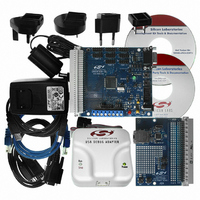ETHERNETDK Silicon Laboratories Inc, ETHERNETDK Datasheet - Page 37

ETHERNETDK
Manufacturer Part Number
ETHERNETDK
Description
KIT DEV EMBEDDED ETHERNET
Manufacturer
Silicon Laboratories Inc
Type
Controllers & Processorsr
Datasheet
1.ETHERNETDK.pdf
(40 pages)
Specifications of ETHERNETDK
Main Purpose
Interface, Ethernet
Embedded
Yes, MCU, 8-Bit
Utilized Ic / Part
C8051F120
Primary Attributes
CMX-MicroNet TCP/IP Protocol Stack
Interface Type
RS-232, Ethernet
Product
Modules
For Use With/related Products
C8051F120, CP2200
Lead Free Status / RoHS Status
Contains lead / RoHS non-compliant
Secondary Attributes
-
Lead Free Status / Rohs Status
Lead free / RoHS Compliant
Other names
336-1284
Available stocks
Company
Part Number
Manufacturer
Quantity
Price
Company:
Part Number:
ETHERNETDK
Manufacturer:
Silicon Labs
Quantity:
135
Ethernet-DK
A
—S
P
PPENDIX
UPPORTED
ROTOCOLS
Link/Physical Layer:
Ethernet (IEEE802.3)—Widely installed local area network link/physical layer.
Internet Layer:
IP (Internet Protocol)—IP specifies the format of packets and manages the addressing of all devices on the
network. IP is included in all builds of the TCP/IP stack.
PING (Packet Internet Groper)—PING is a basic network program which verifies that a particular IP address
exists and can respond to requests. PING is included in all builds of the TCP/IP stack.
ARP (Address Resolution Protocol)—ARP converts higher-level IP addresses to lower-level MAC addresses. It
is not available with SLIP or PPP.
Transport Layer:
TCP (Transmission Control Protocol)—TCP is a connection-oriented transport protocol. It offers a reliable, full-
duplex data stream that may be written to and read from by devices on the network.
UDP (User Datagram Protocol)—UDP is a connection free, best effort transport protocol. It formats data into units
called datagrams and sends them across the network; however, it provides no guarantee that the data will arrive. A
UDP checksum is performed on the data to allow the receiving node the ability to detect data errors.
Application Layer:
DHCP (Dynamic Host Configuration Protocol)—Used to obtain a dynamic IP address from a DHCP server.
BOOTP (Bootstrap Protocol)—Older protocol used to obtain a dynamic IP address.
FTP (File Transfer Protocol)—FTP transfers a complete file from one network device to another. FTP requires the
TCP transport layer. The FTP module in the TCP/IP stack configures the device to operate as an FTP server only.
It cannot act as an FTP client.
HTTP (HyperText Transfer Protocol)—HTTP sends and requests files (typically HTML files) across a network. It
is commonly used to transfer files across the World Wide Web. HTTP requires the TCP transport layer. The HTTP
module in the TCP/IP stack configures the device to operate as an HTTP server only. It cannot act as an HTTP
client or browser.
SMTP (Simple Mail Transfer Protocol)—SMTP sends and receives e-mails. It requires the TCP transport layer.
The SMTP module in the TCP/IP stack can only act as an SMTP client. An SMTP server must be available on the
network to forward emails from the Ethernet-DK to the specified e-mail address.
TFTP (Trivial File Transfer Protocol)—TFTP is a simplified version of FTP. It requires the UDP transport layer.
The TFTP module in the TCP/IP stack can only act as a TFTP client. It cannot act as a TFTP server.
DNS (Domain Name Service)—Allows domain name (e.g., www.silabs.com) to be resolved into an equivalent IP
address.
Netfinder—Allows an embedded system to be identified on a network.
Rev. 0.6
37











